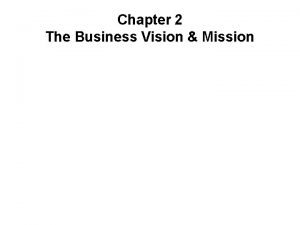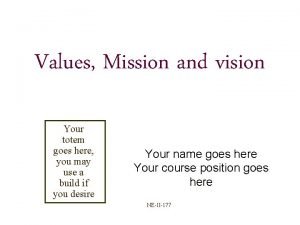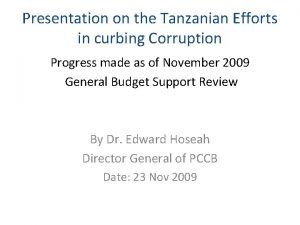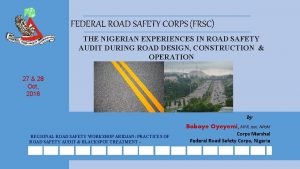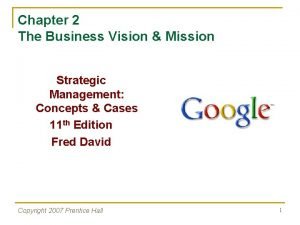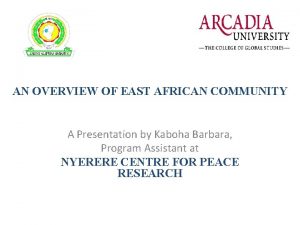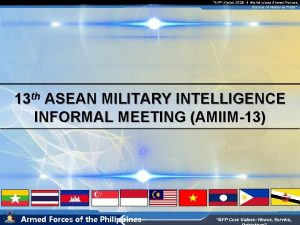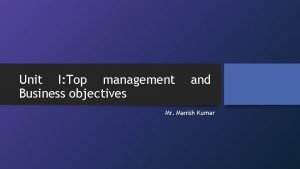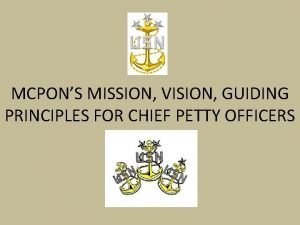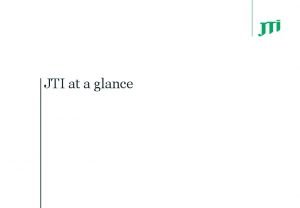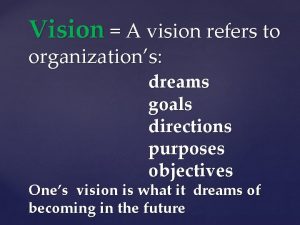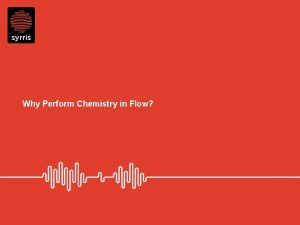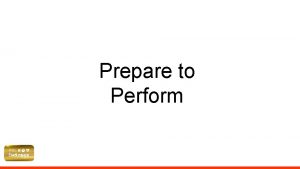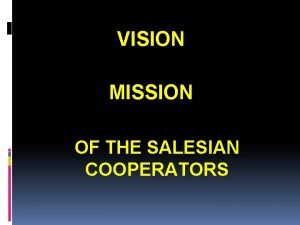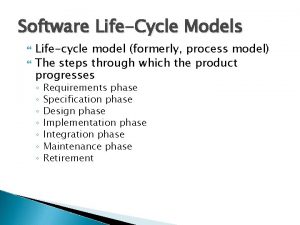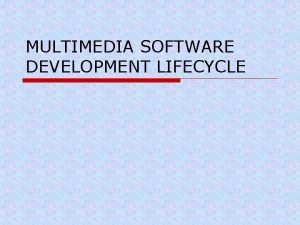PM CAS Mission and Vision MISSION Perform LifeCycle



















































- Slides: 51


PM CAS: Mission and Vision MISSION Perform Life-Cycle Management of Tube-Launched Indirect Fire Munitions, Mortar Weapons, and Mortar Fire-Control Systems VISION Deliver Conventional and Leap-Ahead Munitions Combat Power to Warfighters, Giving them the Materiel Edge over Potential Adversaries

PM CAS Management Imperatives Ø Meet Requirements and Pursue Promising Technologies Ø Promote Competition to achieve Best Value and Drive Down Costs Ø Leverage Investments and Reinforce Successful Partnerships Ø Endorse Teamwork and Employee Empowerment Ø Promote and Employ Disciplined Processes Ø Promote Lean Design and Production Ø Promote Commonality and Interoperability Balance is Essential! Ø Plan Aggressive and Non-Traditional T&E Ø Take Calculated Risks, but Manage and Mitigate them Ø Employ Spiral Development and Continuous Process Improvement Ø Leverage Information Technology and Knowledge Management Systems Ø “Trust, but Verify” – ‘Put Eyeballs On’ to Maximize Situational Awareness

PM CAS Organization PM Combat Ammunition Systems PM, COL Nathaniel Sledge, Jr. DPM, Mr. Rene Kiebler 973 724 -2003 973 724 -2110 PM, LTC Andre Kirnes DPM, Mr. David Super 973 724 -4209 PM, LTC Jeff Wilson DPM, Mr. Chris Grassano 973 724 -3152 Precision Effects Mr. Peter Burke 973 724 -5802 US Army Joint Munitions Command Mrs. Celia Hadden DSN 793 -6491 Business Management Mortar Systems Excalibur Mr. Joseph Gormley 973 724 -5891 Weapons and Fire Control Over 300 People! Mr. Ed Lewis 973 724 -4995 Conventional Ammunition Advanced Systems Mr. Armando Herrera 973 724 -3636 Mr. Steven Hromnak 973 724 -5476 Artillery Mortars Mr. Martin Moratz 973 724 -5247 Mr. John Slivovsky 973 724 -3665 Energetics Mr. Jim Rutkowski 973 724 -2394 OPM CAS ATTN: SFAE-AMO-CAS, Building 171 A Picatinny Arsenal, NJ 07806 -5000 Phone: 973 724 -2573, DSN: 880 - 2573 Fax: 973 724 -2907

Army Transformation: How We Fit In 155 mm M 795 HE 105 mm M 915 DPICM M 782 MOFA 155 mm MACS 155 mm M 864 Recap MFCS 120 mm XM 984 ER Mortar ACAAP Special Operations Modernized CATK Stryker Force 155 mm M 107 HE Forced Entry 81 mm LW Mortar • • Agile Lethal Versatile Survivable Deployable Responsive Sustainable Future Force CCF 155 mm Less-Lethal 2004 60 mm Mortar Family • High Explosive • Smoke • Illuminating • Full Range PC IOC 2010 FOC 2012 81 mm Mortar Family High Explosive 120 mm Mortar Family Smoke • High Explosive Illuminating M 1155 PIAFS • Smoke Full Range PC • Illuminating • Full Range PC Precision/Near Precision/System Support SFM Excalibur PGMM • Unitary • Discriminating

Indirect Fires Investment Strategy (POM 06 -11) I Terms of Reference t RO s e t rea G • Improve precision and deployability • Accelerate technology to Current Force • Better balance investment between Current and Future Forces 75% Future Force e c r o e. F ge d i r B tur u F to 25% Current Force Paladin Mortars Stryker Force LW 155 Networked Joint Mobile Lethal Sustainable Responsive Continuous Survivable Precise Full Spectrum

The Basis for Fire Support Guidance Strategy Guidance • National Military Strategy (NCA) • Joint Vision 2020 (Joint Staff) • Total Army Plan (15 Years) (DA) • Army Transformation Plan (DA) • Total Army Analysis (DA) Plans and Concepts • Army Indirect Fires Strategy (TRADOC) • FCS Organizational and Operational Plan (TRADOC) • Unit of Action Organizational and Operational Plan (TRADOC) • Fires and Effects Concept (USFAS) • FCS ORD (TRADOC) Studies • FCS Analysis of Alternatives (TRADOC) • PGMM Analysis of Alternatives (TRADOC) • FCS Lethality Effectiveness Study • Course-Correcting Fuze Study (USFAS) • Precision Munitions Review (TRAC) Observations • OEF/OIF Observations (31 D, 101 st, 10 th MNT, Rangers) • Trends in Rules of Engagement (ROE), Technology, Doctrine, TTP, and Threat (Multiple) • Known Capability Gaps (TRAC) • USAWC Study on Operations in Afghanistan (S. Biddle)

Transforming Army Indirect Fires Networked through Battle Command Fully Interoperable with Joint systems Mobile (Strategic and Tactical) Responsive & Integrated with Maneuver Challenges Strategic Deployability Networked Capability (C 4) Tactical Mobility Target Location (ISR) Accuracy / Rate of Fire Precision Munitions Discriminating Munitions Lethal (through precision and volume) Precise Effects with Area Options Reduced Sustainment Ability to Mass Effects 24/7, All-Weather, All-Terrain To achieve Destructive, Suppressive and Protective effects while minimizing collateral damage taking advantage of emerging technology

Army’s Direction for Precision Ø DPG (FY 04 -09) : “Smart Artillery Rounds: The Department of the Army will accelerate the Excalibur GPS guided round program. ” Ø Army Modernization Plan (2003): “At the tactical level, we rely on immediately responsive, continuously available, organic fires to enable our units to maneuver. ” Ø Army Report on Indirect Fires (25 July 2002): “The Army fully supports OSD proposals to accelerate Army precision fire initiatives…such as Excalibur by FY 07. ” Ø Unit of Action O&O: Precision fires… “allow small units in the UA to selectively destroy key enemy systems and forces. ” Ø FCS KPP #3: “the UA must have the ability to create lethal and non-lethal overmatch at the time and place of its choosing. The FCS Fo. S must be capable of employing networked LOS, BLOS and NLOS capabilities fully integrated with maneuver to suppress and destroy enemy forces and systems with greater precision, at extended ranges and in close combat. ” Ø SECDEF Lessons Learned from OIF: “Key lessons so far include the importance of precision & the ability to deliver devastating damage to enemy positions, while sparing civilian lives & the civilian infrastructure. ”

Need for Greater Precision and Range FCS ORD Ø The NLOS Cannon provides networked, extended–range fires for precision attack of point and area targets in support of the US with a suite of munitions that include special purpose capabilities. [Para 1. 5. 2. 5. 8. 2. FCS ORD] Ø FCS NLOS Cannon must be capable of firing current ammunition with a total Circular Error Probable (CEP) (including bias and precision error) that does not exceed 0. 55% of range at low angle, for ranges of 30 kilometers or less. [Para 2. 0. 4. 1. 5 FCS ORD, 2172] (i. e. CEP ≤ 165 meters @ 30 km) Ø The FCS Fo. S must be capable of Joint networked lethal and non-lethal effects that achieve overmatch – out of contact, at tactical standoff and in close combat to defeat the target sets detailed in Chapter 4 of the FCS STAR. [Para 1. 5. 2. 5. 5. FCS ORD] Ø The OF will exploit the effects of precision long range fires to close with and destroy the enemy [Para 1. 2. 1. 1 FCS ORD ] Ø … the UA employs destructive fires with great precision at extended ranges against high payoff targets…the increased long-range killing capability of fires will be employed to fix and destroy the enemy…fires ensure freedom of action and maneuver. . [Para 1. 5. 2. 5. 5 FCS ORD] FCS NLOS Cannon must be capable of firing munitions at least 30 km (Threshold) / 40 km (Objective) [Para 2. 0. 4. 1. 4 FCS ORD 2169] Ø

Doctrinal Basis for Precision Ø Expands mission set to include urban operations Ø Addresses concerns about collateral damage Ø Provides Stand-off precision engagement to fix enemy formations and to set the conditions Ø Facilitates engagement of High-Payoff Targets (HPTs), especially before forces are joined Ø Enhances transition to “danger close” operations Ø Presents “move or die” dilemma to entrenched enemy

Doctrinal Basis for Precision Ø Shapes the fight through destruction of HPTs and centers of gravity Ø Makes fire missions quicker, enabling increased OPTEMPO through rapid destruction of HPTs and MDTs Ø Reduces dependence on and frequency of ammunition resupply because of increased efficiency and lethality Ø Enhances close support through reduction in danger close distance

NLOS Mix Study Results (2003) (Relative Participation by Battle Phase) NLOS-C NLOS-LS LOS BLOS Fixed-Wing AVN HIMARS (MLRS) NLOS-M 62 15 Findings and Conclusions: 10 50 0 10 3 4 100 43 40 25 15 22 Ø Range of missions demands robust set of organic fires and effects capabilities. These spectrums of capabilities are necessary across and within the realms of mortars, artillery, rockets, and missiles. Ø Setting the conditions at stand-off is key to conducting decisive operations at friendly time and place of choosing. 0 Ø UA must have extended range, precision artillery fires to begin the attack of HPTs and precision mortars and volumetric artillery fires to engage MDTs while conducting precision maneuver to its position(s) of advantage. 7 Ø Very responsive suppressive fires are required because an adaptive enemy cannot always be targeted, even with an extensive array of layered sensors. Ø Very responsive fire support systems, Networked Battle Command, and execution-oriented targeting processes enable dynamic target attack and unprecedented responsiveness to all echelons of the future Force. 13 0 Ø Analysis shows need for mix of organic NLOS capabilities (mortar, cannon, missile) that optimize the UA for responsive fires. 5 13 6 Comp. 135 169 139 Phase Before Forces Are Joined During Contact Tactical Assault Ø Reach to UE and joint fires provides critical complementary capabilities before forces are joined. Notes: 20 hr. scenario Not in Study

Summary of Army Studies Findings Ø A robust mix of fire support systems is required to address the full spectrum of requirements, to maintain Agility and Flexibility, and to mitigate against surprise Ø Complementary systems increase flexibility and provide scalable effects Ø Lethality, Volume, Precision, Responsiveness (24/7, all weather, all terrain), and Range remain critical attributes of a fire support system Ø Networked, Massed, and Precision fires offer opportunity to disrupt/destroy enemy capabilities at greater depths and with greater precision Ongoing Efforts Ø Determining the best mix of joint fires to meet Objective Force fire support requirements Ø Continuing experimentation and analysis through modeling and simulation and army, joint, and multinational exercises

Mortars Feedback from Operations Enduring Freedom and Iraqi Freedom Ø Mortars were very effective - The primary organic killer Ø Mortars were most responsive and most integrated means of providing close fire support Ø Dispersed but lethal enemy requires more precise fires Ø Mortars proficient at “hip shoots” and at destroying RPG teams in urban environment Ø With spotty re-supply, high number of rounds per point target mission presented serious deficiencies in effectiveness and endurance (e. g. , Required 16 rounds to engage enemy bunkers) Ø 120 mm increased light force lethality - Need Arms Room Concept “We’ve got to get the ARC to all our Forced Entry forces” – LTG Cody, G 3, USA

Cannon Feedback from Operation Iraqi Freedom Ø Cannons paved the way during the historic advance to Baghdad Ø Cannons were the most responsive inorganic fire support asset available for shaping and close fires Ø Cannons provided the majority of close support to committed forces Ø Majority of targets attacked at maximum range Ø Extended-range inefficiency increased the logistics burden Ø Cannon DPICM barely used because of concern about collateral damage, accuracy and duds Ø Copperhead not used because of negative perceptions about ease of use Ø SADARM was the only smart artillery munition available: Destroyed 48 pieces of equipment with 121 rounds

OIF Winners But materiel Ø HEVT is useless without. . . Ø SFMs • Leadership Ø Mortars • Unit Cohesion • Doctrine & TTP Ø M 7 BFIST • Innovation Ø CAS (A-10 s) • Adaptability Ø Paladin SPH Ø Control Measures Ø LRAS 3 (Target Acquisition)

Observation Summary Ø Ground Fire SPT was most Responsive, most Available, and most Adaptive Ø Preferred munitions: HE(VT), SFMs, & Mortars Ø Suppression still required for Most Dangerous Targets (MDTs) because we may never have perfect knowledge about the enemy Ø Extended Range engagements provide greater standoff and improved force survivability Ø Greater Precision needed to enable friendly forces to develop situations out of contact (High Payoff Targets (HPTs)) and to reduce threat of MDTs Ø Implication: Friendly Forces require a robust mix of mortar and artillery capabilities

Threat Trends Ø Asymmetric/Paramilitary Ø Nonrestrictive Rules of Engagement Ø Seeks Cover in Reinforced Structures and Vehicles Ø Operates Widely Dispersed on Nonlinear Battlefield Ø Interspersed with Noncombatants Ø Seeks Sanctuary in Urban and Complex Terrain Ø Exploits Terrain and Geography Ø Possesses Electronic Countermeasures

Trends in Rules of Engagement (ROE) Ø Minimize Collateral Damage to Protect. . . ü Noncombatants ü Religious and Cultural Landmarks ü Socio-Economic Infrastructure (METT-TC Context) Ø Minimize Unexploded Ordnance Ø Conduct Less-Lethal Operations ü Transition to SASO ü Scalable Fires and Effects

Trends in Doctrine and TTP Ø Ø Ø Ø Emphasis on strategic and operational mobility Network Centric Warfare (Fires and Effects) Dynamic Force Tailoring Primacy of C 4 ISR, Fire Direction and Control Reduced Collateral Damage Expectation of More Efficient Fires Reduce Logistic/Footprint Need for Standoff Range to Shape and Set Conditions Joint and Multinational Fires and Effects Scalable Effects (agile, flexible, versatile, and complementary) Greater Integration of Fires and Maneuver Capabilities Based Requirements Proliferation of Targeting Devices (Acquisition and Locating) Use of Special Purpose Fires (Non-lethal and unmanned ground sensors)

Trends in Technology Ø Ø Ø Ø Miniaturization of processors (deeply integrated guidance) GPS/SASSM MEMS Robotics Materials Automation Thermobarics Power Sources Non-/Less-Lethal Sensors (LADAR) Nanotechnologies/Energetics Improved software and algorithms Increased data storage and bandwidth

Joint PGM Assets

Mix of Joint Fire Capabilities Interdiction Joint Fires and Deep Attack Range >300 km Air Interdiction 300 km ATACMS 225 km (LAM) 150 -180 km UCAV Attack AVN 70 km 60 km (PAM) 30 -40 km Shaping/Shielding Fires PAM/ LAM Cannons Naval Gunfire GMLRS 10 -15 km CAS Mortars Protective Fires Close Support Fires Response Times TLAM

Field Artillery Precision Assets Fielded In Development Exploration/Tech Demo Note: TLE=0 m

Field Artillery Scalable Precision 10 m M 864 CEP M 549 CEP M 864&M 549 w/CCF Excalibur Target Grid 10 m 35 km 50 m 10 m m 273 139 m 50 m 10 m 273 m 30 112 m 50 m 212 m 95 m 131 m 89 m km 25 km 20 62 m km 15 km 10 km Source: AMSAA data for unccorrected M 864 & M 549

Precision Versus Range (155 mm Cannons and 120 mm Mortars) Interdiction Joint and Deep To 500 Km Shaping and Shielding Close Support Protective 274 m AC AA P 300 To 70 Km CEP (M) 200 5 Area Fires 79 M m 0 m 12 70 m 50 55 m 10 0 TS w/P P A CA A 100 75 125 m PGMM 90 m 7 0 M 1 /PTS M 107 w M 795 w/CCF Near Precision Fires BB ACAAP w/CCF RAP ACAAP w/CCF 50 m Precision-Guided Fires Excalibur Terminally-Guided Fires 10 m Copperhead Range (KM) 10 Km 15 Km 20 Km 30 Km 40 Km

Munitions Characteristics Matrix (Relative Performance Scale) Characteristics Munitions Wt. Excalibur PGMM CCF HE 155 HE 120 HE Precision 5 2 1 3 5 4 Accuracy 4 2 1 3 3 3 Effective Unit Lethality 4 1 1 2 3 3 Collateral Damage 4 2 1 4 5 5 Mission Breadth 3 1 3 2 3 4 Range (max) 5 1 3 2 2 4 Range (min) 3 4 2 4 3 1 Danger Close 5 3 1 3 5 3 Environmental Sensitivity 4 1 3 2 3 3 Susceptibility to CM 3 3 3 2 1 1 Operational Ease 3 1 2 2 Integration with Maneuver 2 2 1 1. 9 2. 5 3. 2 2. 8 Composite LEGEND: Best 1 2 3 4 5 Worst

Capability Gaps and Needs Current Force ØPrecision ü Collateral Damage ü Urban Operations ØAccuracy ØRange ØLethality ØOperational Efficiency ØRobustness Ø Special Purpose ü Weather Ø Sustainability ü Complex Terrain Ø Safety ü Scalable Effects Ø Readiness and Training Ø Mobility Ø Responsiveness Ø Automation Ø Cost Effectiveness Future Force

Capability Gap Matrix

Bridging the Gaps Sustainability • • • Excalibur PGMM CCF MACS Lt. Wt. Mortar Precision Range • • • Excalibur ACAAP PGMM ER Mortar Arms Room Concept • • • Training/Readines s • • • CAP MACS 81 mm Insert Responsiveness • • • Cargo HPM Less-Lethal Obscurants Illumination Thermobaric MFCS EPIAFS & MOFA NLOS-C & NLOS-M Fires Network • • • MFCS PGMM ATR Excalibur NLOS-C with PTS Target Designation Initiatives Sheafing Techniques Sensor Fused Munitions Lt. Wt. Mortar NLOS-M NLOS-C Stowed Kills e. SDF 120 mm Breech CAP Automation • • • Robustness • • • Spectrum of Capabilities Complementary Munitions Mix 24/7 All Weather (Profiler) All Terrain (NLOS-M, NLOS-C) • • Ammo Handling Fire Control Fuze Setters Modular Charges Inventory Management Dynamic Target Attack Target Deconfliction Target Acquisition Sensor Fusion Lethality Accuracy • • Mobility • Special Purpose Safety Excalibur PGMM CCF MFCS PTS Cost Effectiveness • • • NPMs, PGMs, TGMs, & SFMs ACAAP and MFCS Lean Acquisition Spiral Development Modular Charges Increased Rates of Fire & MRSI Angle of Incidence (Excalibur) Novel Warheads (ACAAP, PGMM, & 60 mm MAPAM) e. SDF SFMs TGMs, (PGMM, Copperhead) Arms Room Concept

Fires Transformation: Precision - Accuracy - Range Means Ends Why? What? Ø Speed Defeat of Enemy Thru Quicker MATERIEL Engagements Ø Achieve Capability Overmatch Ø Set Conditions and Shape the Battle: ü Strike Deeply with Precision ü Extend Range of Conventional Artillery ü Facilitate the Close Fight ü Enhance Force Survivability ü Destroy HPTs and MDTs Ø Improve Mission Effectiveness ü Enhance Unit Lethality ü Kill More with Less ü Improve Prob. (Kill / Acquisition) Ø Complement Other Munitions to increase OPM CAS Products Flexibility and Scalability Ø Increase Robustness ü Flexibility ü Scalability ü Adaptability ü Hard Targets ü Moving Targets ü Complementary Effects ü Danger-Close Operations ü Expand Mission set to MOUT ü Operate in Varied and Complex Terrain Ø Reduce Fratricide Ø Address Trends in. . . ü Technology ü Doctrine and TTP ü ROE – Collateral Damage ü Threat – Entrenched and Interspersed in Structures Ø Reduce Logistics Burden: ü Improve Accuracy ü Improve Efficiency ü Free Up Lift Assets ü Increase Stowed Kills ü Reduce Number of Platforms ü Reduce Frequency of Resupply PGMM Excalibur CCF ACA 2 P SFM MFCS 120 mm ER Mortar Interoperability Ø Fire Support Network Ø Logistics System Ø Joint Fires Ø NLOS-M Ø NLOS-C Ø Paladin Ø LW 155 Ø UAVs Ø PTS Other Systems Ø BLOS Ø JCM Ø LAM Ø PAM Ø LOS Ø FWA Ø NLOS-LS Ø ATACMS Ø HIMARS Ø APKWS Ø GMLRS Ø MLRS Ways How? 1. Improve Precision 2. Improve Accuracy 3. Improve Range Ø Improve Mobility for Hi OPTEMPO Ø Increase and Improve Automation Ø Improve Rates of Fire Ø Improve Fire Control and So. Lns Ø Employ Automated Asset Tracking Ø Employ Target Mensuration & Sheafing Techniques Ø Deeply Integrate Guidance, Navigation and Control Ø Develop New Seekers (LADAR) Ø Address Target Location Error: ü Improve Target Acquisition & Locating Devices ü Increase Density of Target Location Devices Ø Assess Complementary Nature of Weapons Ø Emphasize 5 Predictive Elements of Accurate Fire Ø Interoperate with Joint Platforms, Networks, and Sensors Ø Acquire Extended Range Artillery Ø Address DOTLM-PF ü Joint Effects Integration ü Universal Observer ü RSTA & FIST - Equip & TTPs Ø Develop NPMs – Accuracy, Range, and Efficiency Ø Develop PGMs – Range and Precision Ø Develop TGMs – Accuracy and Lethallity Ø Acquire SFMs

Highest Priority Development Programs Excalibur System Description: Precision strike round with Precision Guided, Extended Range 155 mm projectile extended range and enhanced lethal mechanism technology Requirements: Greatly increased precision and reduced Requirements: collateral damage Requirements: Capability to hit point targets Goal: Precision, Range ACAT: I Low cost, fuze-sized module resulting in Goal: Range, Lethality, Accuracy IC: FY 06 (LW 155) IOC: FY 08 projectile CEP <50 M at max range ACAT: Il Status: SDD Goal: Near Precision IOC: FY 10 POC: LTC Jeffrey Wilson IC: FY 07 IOC: FY 10 Status: SDD contract award scheduled Status: Developing co-operative 3 QFY 04, following JROC approval. program with Navy Precision POC: Mr. Pete Burke POC: Mr. Russ Hill System Description: A NATO-size fuze that provides ballistic course correction for spin stabilized artillery projectiles Course Correcting Fuze Mortar Fire Control System Accuracy Range Lethality Robustness System Description: Links mortar fires with the digital battlefield Requirements: Allow mortar crews to send System and receive digital call for fire messages Description: Goal: Accuracy, Responsiveness ER-DPICM round made IOC: FY 03 with lightweight composites Status: Fielding round and rocket motor for POC: MAJ James Winbush increased range Requirements: 50% greater range Goal: Range, Lethality IOC: FY 11 Status: STO UFR POC: Mr. Pete Burke 120 mm ER Mortar Precision Guided Mortar Munition Advanced Cannon Artillery Ammunition Program System Description: Extended range NDI projectiles Requirements: System Increased Lethality through Pff technology Description: Goal: Range, Ballistic Similitude Autonomous, fire and forget, all weather 155 mm IOC: FY 06 SFM projectile Status: Safety Testing Requirements: Destroy or POC: Mr. John Immobilize stationary SPHs and Irizarry other hard point targets Goal: Lethality IOC: N/A Status: Accessing foreign NDI projectile compliance with JBMOU POC: Mr. Russ Hill Sensor Fuzed Munitions

Roadmap for Top Programs FY 04 Mortars FY 06 FY 07 FY 08 FY 09 FY 10 FY 11 Key SBCT Mortar Fire Control PGMM FY 05 NLOS-M PGMM Concept Demo SDD Production Unfunded MFCS Production SW Upgrades NLOS-M FMR SDD Production MS C MS B Production SDD CDT ER IOC 155 mm Artillery Excalibur Unitary Production IOC Early Fielding Discriminating - SDD MS C MS B CCF CDT SDD - Navy-MC-Army MS C MS B ACAAP Safety/Gun Qual Production MS C SFM JBMOU Compliance Production IOC

2004 Precision-Related Objectives Ø Conduct Successful Excalibur Guided-Gunfire-A Test Series Ø Award and Kickoff the PGMM SDD contract Ø Manage the cooperative CCF/GIF program with the Navy. (Secure Additional Funding) Ø Secure additional funding for the ACA 2 P Ø Secure S&T funding for the 120 mm XM 984 Extended-Range, Field MFCS Cargo-Carrying mortar Ø Kickoff light-weight MFCS Program

Enabling Technologies Insensitive Energetics Hardened & Compact GPS/IMU Increase Bandwidth SFM Automation Ammo Marking Inventory Control Ammo Condition Indicators ATR/ Discrimination Tech Next Generation GPS SAASM Deeply Integrated Guidance Enhanced Fuze Setter (EPIAFS) Composite Materials Lower TLE’s Digital Fire Control (LW 155) Improve Battery Tech Network Efficiency & Reliability Improve Sensors GPS Codes Modeling & Simulation IFF MEMS Fuzing Telemetry/Datalink Rocket Assist Tech Force-Level Models Fire Control Algorithms Decision Support Tools

Summary Ø Promoting a modern organization and philosophy Ø Transforming cannon and mortar fire support munitions based on guidance, concepts, trends, and observations Ø Fire support materiel transformation is characterized by improvements in precision, accuracy, range, lethality, robustness, responsiveness, and scalability Ø Key precision products: Excalibur, PGMM, CCF, MFCS, ACAAP, SFMs Ø Seeking improved Enabling Technologies



Other Developments Self-Destruct Fuzes System Description: Submunition Fuze to System reduce battlefield UXO Description: Requirements: UXO less than 1% Inductively settable Multi-Option Fuze for Goal: Lethality, Safety Artillery IOC: FY 04 Requirements: Compatible Status: In Production with bursting projectiles Goal: Reduced Logistic Burden POC: Mr. Bill Vogt & HOB accuracy IOC: FY 04 Status: In Production POC: Mr. Tony Barreiro Lt. Wt. Mortar System Description: STO to reduce the weight of the System M 252 81 mm Mortar System Description: Requirements: 30 to 40% lighter weapon system Modular propellant Goal: Mobility, Portability 155 mm artillery IOC: TBD ammunition Status: Trade Studies Requirements: Auto-Loading POC: Mr. Ed Goal: Increased Range, Reduced Costs Lewis IOC: M 231 – FY 03, M 232 – FY 04 Status: In Production, Fielding POC: Mr. Jim Rutkowski MOFA MACS Arms Room Concept M 864 Recap System Description: “Like new” DPICM System Description: Provide Light Forces rounds with grenade Self Destruct Fuzes maneuver commanders with 81 mm and (SDFs) for the Stryker Brigade Combat Teams 120 mm mortar support System Requirements: Submunition Self Destruct Requirements: HQDA G 3 approved Description: capability for 155 mm artillery ammunition BOIP change July 03 Mortar Anti-Personnel Designed for kinetic (<1% UXO) Goal: Lethality, Range, Flexibility Anti-Materiel (MAPAM) energy mitigation of Goal: Recapitalization, Safety 60 mm HE cartridge with ball IOC: Fielding carrier to minimize IOC: FY 05 bearing fragmentation Status: Recap Feasibility collateral damage Status: Seeking additional Study Ongoing Requirements: Perform a side by side Requirements: Lightweight with funding comparison of the MAPAM with the M 720 A 1 POC: Mr. Parachute Delivery POC: Mr. Ed Cartridge, analyzing Lethality and Effectiveness David Goal: Dispense Less-Lethal Payloads Lewis Kondas IOC: TBD Status: Concept Studies Goal: Lethality IOC: TBD Status: SDD POC: Mr. John Slivovsky POC: Mr. Steve Hromnak Less-Lethal Munitions 60 mm Modernization

PM CAS Thrusts Get PGM’s & Smart Weapons to Warfighters Ø Executing Excalibur PGM Advanced Development Ø Transitioning PGMM to Advanced Development Ø Managing the Course-Correcting Fuze (CCF) Technology Demonstration Ø Fielding Mortar Fire Control System Heavy (MFCS-H) and Developing MFCS-Light Ø Executing Sensor-Fuzed Munition (SFM) Compatibility Assessments Satisfy Customers and Achieve Excellence Ø Ø Ø Seeking funding for the 120 mm Extended Range Mortar Program Seeking funds for the Mortar Arms Room Concept Monitoring Lightweight Mortar and Less-Lethal Munitions Science & Technology Objectives (STOs) Working to Ease Transition of Science Technology Objectives into Advanced Development Developing Strategic Plan and Business Practice Guidelines and Harmonizing Business Practices with the Joint Munitions Command Developing Value Engineering and Cost Reduction Plan Improve and Sustain Conventional Munitions Ø Ø Ø To meet FCS Emerging Requirements for Munitions, Working with Proponents to Develop Capabilities such as the NLOS-M, the Advanced Cannon Artillery Ammunition Program (ACA 2 P) and Course Correcting Fuzes Fielding the Modular Artillery Charge System (MACS) to the active force Producing Bomblet Self-Destruct Fuzes Reengineering selected Munitions, such as the 60 mm Mortar (HE) and 155 mm M 864 (DPICM) Reengineering Pyrotechnic, Explosives, and Propellants (PEP) for Improved Effectiveness, Safety, Insensitivity and Environmental Compliance Grow World-Class People and Teams Ø Ø Ø Emphasizing Improved Communications Disseminating the PM CAS Management Philosophy and Disciplined Processes to Partners in Industry and Government Reshaping and Reorganizing the Workforce Developing Individual and Team Training Strategies Launching Leadership Competency Training Program Hiring, Recognizing, and Promoting the Meritorious

The Road Ahead Ø Leverage guidance, studies, concepts, experiments, operations, and trends Ø Determine capability gaps and materiel needs Ø Pursue integrated fires and effects Doctrine and TTP Ø Develop integrated fire support systems strategy Ø Obtain validated requirements Ø Clarify army funding priorities Ø Leverage enabling technologies Ø Execute and protect the strategy

Networked What is the Correct Objective Force Indirect Fire Balance? Ø Sensors - JSTARS - U 2 R - TENCAP - Multi-mode Radars - Air Defense Radars - Aerial Common Sensor - Space Based Sensors - A 2 C 2 S - Comanche - UAV Ø Shooters ü ü ü ü NLOS Mortar • Simulation NLOS Cannon • Experimentation HIMARS • Analysis Attack helicopters Joint Air (CAS, AI, SOF) NLOS-LS and TLAM-like missiles Unmanned Combat Aerial Vehicles (UCAV) Fully Capable Force Ø Munitions ü PGMM, Excalibur, LAM, PAM, ATACMS, Other Svc’s Munitions, G-MLRS AFAM, MSTAR “The department must have multiple joint and service-centric concept development efforts underway to ensure a robust competition of ideas. ” – Transformation Planning Guidance (2 nd Draft)

Generalized Attributes of Indirect Fires Transformation Army Indirect Fires provide increased flexibility and overmatch lethality to maneuver commanders in the Future Force by being: Ø Responsive – Tactically responsive and fully integrated with maneuver. Ø Deployable – Inter- and intra-theater using air and sea lift. Ø Agile – Better manages battlefield transitions, such as retargeting and dynamic target attack Ø Versatile – Provides greater mission breadth through scalable effects in all physical environments. Ø Lethal – Achieves suppressive, protective, and destructive effects [through mass, precision, accuracy, and rates of fire]. Ø Survivable – Optimizes organic crew protection, maneuverability and tactical responsiveness. Ø Sustainable – Reduces logistic demands through the integration of conventional and precision fires.

Ground Munitions Terminology Ø Area Fire Munitions (AFM) – Achieves sufficient precision at short to medium ranges to suppress, neutralize or destroy dispersed area targets (M 934 mortar, M 107, M 795, M 864, M 549, ACAAP) Ø Near Precision Munition (NPM) – Achieves greater precision to suppress, neutralize or destroy area targets, using fewer munitions than for AFM fire missions, and at medium to long ranges (M 864 w/ CCF, ACAAP w/ CCF) Ø Precision–Guided Munition (PGM) – Maneuvers to engage an area or point target with sufficient accuracy to suppress, neutralize or destroy it. (Excalibur, ERGM, LRLAP, BTERM) Ø Terminally–Guided Munition (TGM) – Locates, identifies and maneuvers to hit a point target with accuracy sufficient to result in a high probability of target destruction (PGMM, Copperhead) Ø Smart or Sensor Fuzed Munition (SFM) – Detects target signature and hits the target to neutralize or destroy it (SADARM, SMArt 155, Bonus) Ø Special Purpose Munitions (SPMs) – Includes obscurants, illumination, mines, unmanned sensors, cargo, reconnaissance, HPM, thermobaric, and less -lethal munitions

Indirect Fires Ø What? ü Indirect fire support systems consist of mortars, cannons, rockets and missile launches, attack helicopters, UAVs and joint air/sea platforms Ø Why? ü Suppressive and Protective Fires – To facilitate the ground commander’s ability to maneuver his forces ü Destructive and Protective Fires – To enhance the ground commander’s ability to conduct assaults and defenses ü Protective Fires – To ensure and enhance ground force survivability ü Destructive Fires – To reduce the enemy’s warfighting capability, speed his defeat, and reduce the need for direct assault.

PM Combat Ammunition Systems

Precision Related Terminology Actual Target Location MPI (1) x Target Location Error (TLE) Precision Error is the uncorrelated variation about the Mean Point of Impact (MPI) for a given mission MPI (3) MPI (2) x Aimpoint Bias (MPI) Error is the occasion to occasion variation in the MPI about the aimpoint Ø Delivery Accuracy – Ability to hit an aimpoint, includes both Precision and Bias errors. Often referred to as "Precision" for guided munitions when bias is insignificant. Ø System Accuracy – Ability to hit the target for a given mission. Is a function of Delivery Accuracy and TLE. Ø Precision Fires – The capability to destroy selected high-value and time-critical targets, or to inflict damage with precision, while limiting collateral damage. Ø Precision Engagement – A system of systems that enables our forces to locate the objective (or target), provide responsive command control, generate the desired effect, assess our level of success, and retain the flexibility to reengage with precision when required.

Munitions for Point Targets

Munitions for Area Targets

Munitions Mission Breadth
 Bellevue hospital mission statement
Bellevue hospital mission statement Lenovo core values
Lenovo core values Wooqer vmart
Wooqer vmart Ibm vision and mission statement
Ibm vision and mission statement Boy scout vision and mission
Boy scout vision and mission Mission and vision of cleanliness
Mission and vision of cleanliness Herbalife vision and mission
Herbalife vision and mission Vision of pccb
Vision of pccb Big bazaar mission and vision
Big bazaar mission and vision Tesla mission and vision statement
Tesla mission and vision statement City of harare vision and mission
City of harare vision and mission Herbalife mission statement
Herbalife mission statement Mission statement for cupcake business
Mission statement for cupcake business Vision and mission of itc company
Vision and mission of itc company Non governmental vision mission goals and objectives
Non governmental vision mission goals and objectives Different between vision and mission
Different between vision and mission Plmar mission
Plmar mission Gde vision and mission statement
Gde vision and mission statement Gde strategic goals
Gde strategic goals United nations road safety
United nations road safety Evangelical church winning all
Evangelical church winning all Vision vs. mission
Vision vs. mission Mission and vision of strategic management
Mission and vision of strategic management Sabrina vincent
Sabrina vincent Bakery vision and mission
Bakery vision and mission Eac mission and vision
Eac mission and vision Afp vision
Afp vision Vision without action
Vision without action Difference between vision and mission
Difference between vision and mission Red cross youth mission and vision
Red cross youth mission and vision Gde vision and mission
Gde vision and mission Microsoft empower every person
Microsoft empower every person Mission vision guiding principles navy
Mission vision guiding principles navy Jti mission and vision
Jti mission and vision 10 pillars of education in gauteng
10 pillars of education in gauteng Kaiser mission and vision
Kaiser mission and vision Alibaba group mission statement
Alibaba group mission statement Iqor mission and vision
Iqor mission and vision What is boeing's mission statement
What is boeing's mission statement Saint louis university mission and vision
Saint louis university mission and vision Boy scout mission and vision
Boy scout mission and vision Core values of usi
Core values of usi Corporate culture disney
Corporate culture disney Vision example for food business
Vision example for food business Equity bank mission and vision
Equity bank mission and vision Malaysia airlines mission and vision
Malaysia airlines mission and vision Asus mission statement
Asus mission statement Vision de herbalife
Vision de herbalife Herbalife vision and mission
Herbalife vision and mission Cupcake sizes
Cupcake sizes Eccd mission and vision
Eccd mission and vision School vision statement template
School vision statement template
